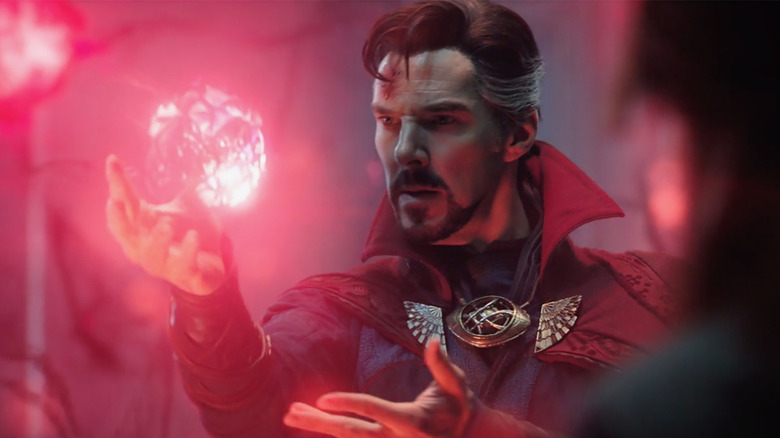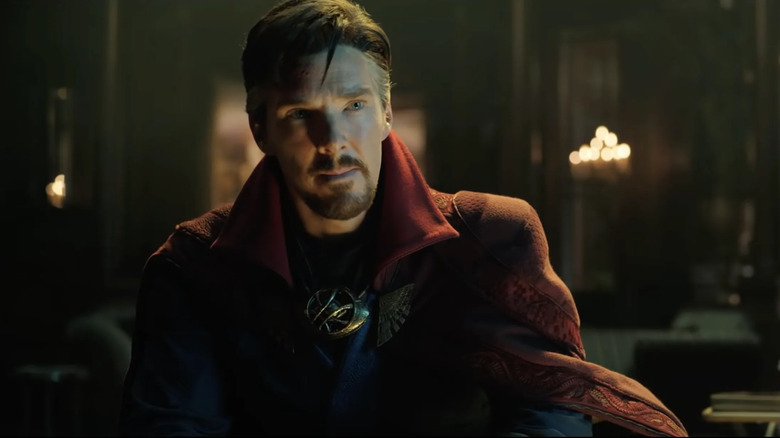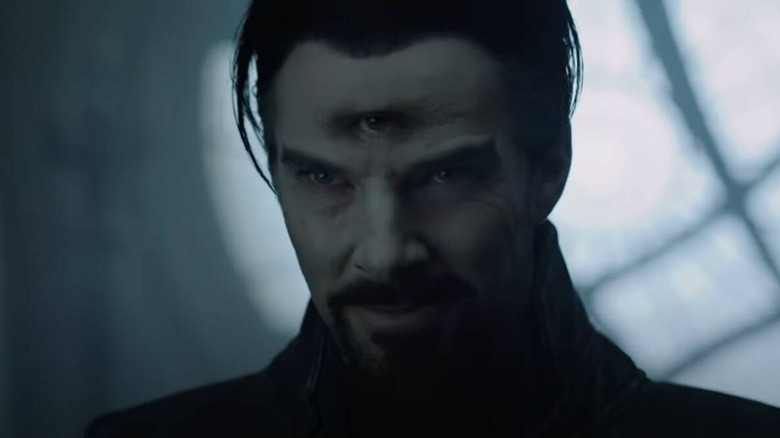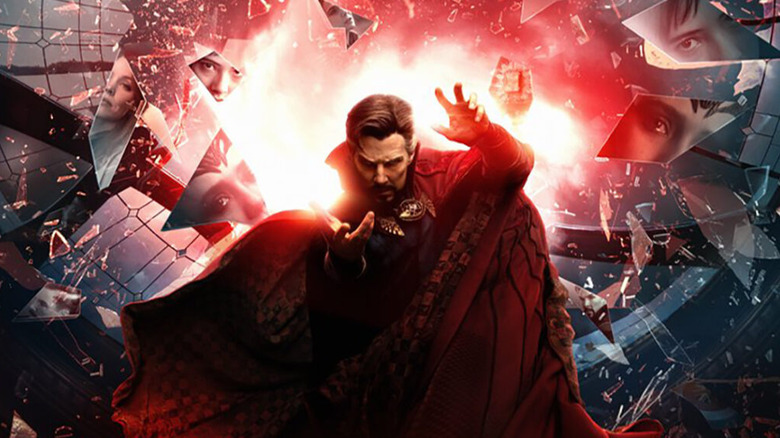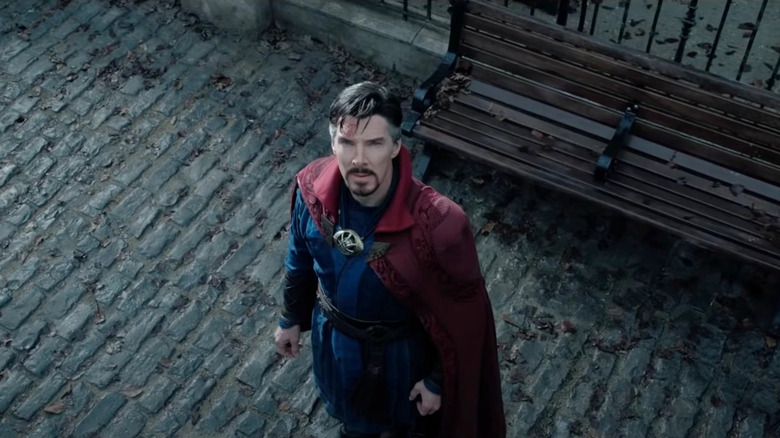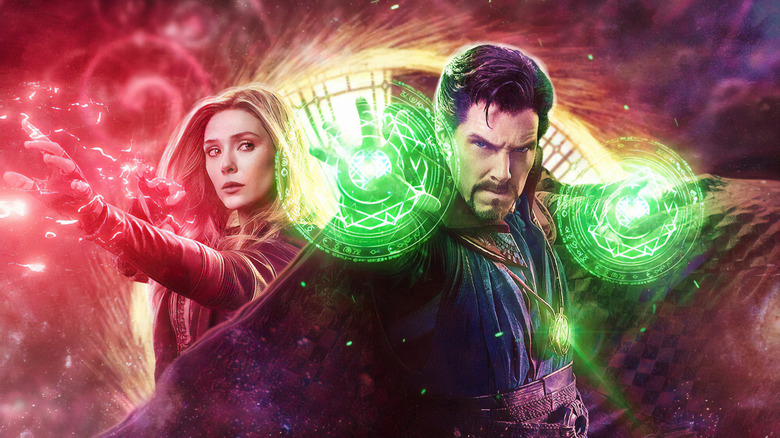Doctor Strange In The Multiverse Of Madness Ending Explained: You Either Die A Hero, Or...
Sam Raimi's first film in nine years, "Doctor Strange in the Multiverse of Madness" has finally hit the street, and all its secrets are out. The plot twists can be revealed, the surprise multiverse cameos can be openly discussed, the expectedly slick special effect can be marveled over, and the credits cookies can be deciphered for outsiders. The hype machine will continue apace for a few more weeks before discussions of this, the 28th feature film in its series, will begin to fade in favor of the 29th ("Thor: Love and Thunder," due in theaters this July) and the 30th ("Black Panther: Wakanda Forever" due in November). Until July, MCU fans will have a dandy time celebrating the multiverse and its corporate versatility when it comes to inducting Fox-owned Marvel characters into the series' central narrative, as well as a handy way to resurrect dead characters, or recast aging ones.
Apologies for any perceived weariness, but despite fleeting moments of bonkers horror energy compliments of the director of "Army of Darkness," "Doctor Strange in the Multiverse of Madness" feels slight, dismissible, and weirdly shabby for a film of its budget. The film's notable fan service moments are nicely undercut by a few moments of exciting violence, and the third act incorporates some gloriously skeletal haunted house imagery that is certainly welcome in the notoriously soft-edged MCU, but the plot is the usual hooey about villains trying to amass a greater amount of magical power, kidnapping, and flinging bolts of CGI between two superpowered figures who are so closely matched in abilities, one wishes they would simply arm-wrestle instead.
Is "Madness" weird? It's certainly weirder than most films of its ilk. And its ending provides a longer perspective on the character arc of Doctor Stephen Strange that is proving deeply unusual for a superhero character. Indeed, when looked at in the right light, we may have been witnessing the origin story of a supervillain this whole time. Before delving into the details of "Multiverse of Madness," however, let us walk through where we have been with the good doctor, and what a bloodthirsty eff-up he's been.
Doctor Strange's character arc
Scott Derrickson's 2016 film "Doctor Strange" was an origin story. The title character (Benedict Cumberbatch) was a talented but arrogant surgeon who enjoyed money and acclaim just as much — if not more so — than helping patients. People were drawn to his confidence, but put off by his bluster. He was certainly lined up for a lesson in humility. He gets it when a car accident — don't text and drive, kids — injured his hands. His quest to find a cure leads him to inject vampire bat DNA into ... sorry, that's Morbius. His quest to find a cure leads him to an ancient order of mystical monks in the mountains who teach him to meditate away his pain, but also the secrets of magic and spellcasting. By the end of the film, Doctor Strange has visited pocket dimensions, had his soul removed from his body, learned how to summon teleportation portals, and control the very flow of time. And, I suppose, some humility was mixed in?
Doctor Strange seems to have learned very little by the end of his 2016 origin. He didn't learn to live without the use of his hands, but instead to push and harangue monks, break rules, and gain more power by doing so. He adopted a philosophy of "extreme measures work best." He learns no appreciation for nuance. The fact that he traps himself in a time loop with a Lovecraftian demon, allowing himself to be slaughtered hundreds and hundreds of times is something that he seems to shake off by the following scene.
Moving forward, through multiple other film appearances and into "Multiverse of Madness" Doctor Strange will prove time and time again what a terrible wizard he is, often resorting to extreme measures as a first step. In the 2018 film "Avengers: Infinity War," Doctor Strange, eager to find a way to defeat the ultra-powerful genocidal alien Thanos (Josh Brolin), used his powers of prognostication to see if he and the myriad other superheroes could "defeat" him. He says he found one path forward. In 2019's "Avengers: Endgame," we learn that his plan was to allow Thanos to commit genocide, wait five years, and then use an omnipotence widget to resurrect everyone, killing Thanos in the process.
Doctor Strange's character arc, part 2
That "There's only one path forward" statement from "Infinity War" sounds a little bit like hooey to me. Was there no way to convince Thanos that genocide was a bad idea? Personally, I was always uncomfortable with Iron Man's actions at the end of "Endgame," as it showed a man who had previously been committed to ridding the world of weapons of mass destruction — an ostensibly smart and creative character — in possession of an instrument capable of granting him any wish, using said instrument AS a weapon of mass destruction. His final act was taking hundreds, if not thousands, of lives.
Some reflection may reveal that Tony Stark (Robert Downey, Jr.) only thought to murder thousands because of Doctor Strange's prophecy. I am convinced that Doctor Strange wasn't looking for a future wherein Thanos could have been placated, convinced to join the side of good, or simply call off his murderous quest, but a future wherein the heroes were permitted to execute him. This theory bears out in an episode of "What If...?" wherein Thanos, so moved by the righteousness of Black Panther (Chadwick Boseman), did indeed join the side of good. Did Doctor Strange not see that possibility in the 14 billion futures he saw? It makes one suspect that Doctor Strange was perhaps a little bloodthirsty and vainglorious. That he secretly wanted the death. He is, after all, an egocentric drama queen. Perhaps he was more comfortable with half the galaxy being dead for five years than a quiet chat with Thanos.
And, of course, most audiences can see the immediate issue with Doctor Strange's solution to Peter Parker's problems in 2021's "Spider-Man: No Way Home." In that film, Spider-Man (Tom Holland) asks the good doctor to erase the world's memory of his secret identity (previously made public by a supervillain), specifically because his infamy hurt his friends' chances at getting into a good school. It's not until after Doctor Strange casts the spell — tearing reality asunder in the process — that either of them thinks that Peter could easily have appealed to the school board rather than immediately leaping to reality-bending superpowers. When Doctor Strange realizes his memory spell somehow unleashed villains from other movies into his own, his first solution is to send them back to their home dimensions, effectively killing them. He makes some mealy-mouthed comment about how killing them restores some ill-defined balance to something-or-other.
Did Doctor Strange just, once again, advocate for brazen execution? He's a bad wizard, he's not very smart, and he wants people dead. This is sounding less and less heroic by the moment.
Doctor Strange, Earth-838
An interesting parallel for Doctor Strange appears in "Multiverse of Madness." After slipping through an aperture between worlds, Doctor Strange and his compatriot American Chavez (Xochitl Gomez) find themselves in what will eventually be designated Earth-838 (the universe the MCU is used to is Earth-616). The two seek out Earth-838's version of Doctor Strange, only to find that he has died and was memorialized as a statue in front of his New York home. Evidently, Strange-838 died while fighting Thanos in this universe.
That memorial, however, will prove to be a misdirect. Earth-838's Illuminati (a secret cabal of superheroes) lets Strange-616 in on a secret: Their Doctor Strange had actually become mad with power in the course of fighting Thanos, and had, through his growing villainy, destroyed an entire dimension. Yes, this Doctor Strange had taken possibly quadrillions of lives. As such, one of the Illuminati executed him, and the organization agreed to vaunt him as a hero.
This sounds an awful lot like what Strange-616 was in the middle of. He was certainly vaunted as a hero after the Battle of Thanos, but his awful mistakes and extreme philosophy stand in contrast to his reputation. It seems like Strange-616 might be fated to follow in his 838 doppelganger's footsteps. Is this the fate of all Doctors Strange? Later in "Madness" Strange-616 will meet an additional version of himself, and find that he, too, has chosen a path of evil.
A perceptive critic might also note that there is a parallel between Doctor Strange and the Scarlet Witch (Elizabeth Olsen), another magical being who has been lured into evil and selfishness. Their long bend toward injustice could, of course, be a repetition of that old axiom of absolute power corrupting absolutely, but such stories often feature redemption. The Scarlet Witch has a goal she can perhaps rethink. While clearly motivated toward evil, there may still be a sense that the once-heroic Wanda Maximoff can be convinced to behave otherwise. Doctor Strange's only goal is to complete the task in front of him at all costs, and aims to gain more and more power in order to do so. Power? Corrupting?
Into the Multiverse of Madness
At the end of "Doctor Strange in the Multiverse of Madness," Stephen finds himself trapped in an alternate dimension doing battle with an "evil" version of himself. The Evil Strange has been corrupted by the influence of an ancient book of spells called The Darkhold, the MCU's version of The Necronomicon. While there is symbolic might in seeing the ostensibly "good" Doctor Strange defeat an evil version of himself, one may not be so sure it was the "good" version that won. Once Evil Strange has been vanquished, Stephen immediately sets up a Satanic circle of candles and uses the dark magic from the Darkhold to commit a brazen act of necromancy, shunting his consciousness into his own corpse (handily provided from yet another parallel universe).
In another example of Doctor Strange abiding by his philosophy of "extreme solutions first," he harnesses the power of damned souls to face off against the Scarlet Witch, who aims to suck multidimensional powers out of America Chavez. Not only will this ensure that no one is able to come after her, it will also give Wanda the power to protect Billy and Tommy if, say, one of them catches a disease that can only be cured in another universe. With a trail of bodies already in the Scarlet Witch's wake, what's one more?
During the final conflagration, a zombified Doctor Strange, armed with demons, finds that he is still not powerful enough to murder the Witch. In a telling moment, America asks Doctor Strange to suck out her powers instead — that is: kill her in the exact same way that Scarlet Witch was going to — in order to prevent the villain from getting power.
Fortunately, Doctor Strange is able to pull back from complete supervillainy in this moment, instead giving America a pep talk that allows her to break through her mental block and use her powers deliberately for the first time. Exposing the Scarlet Witch in all her rampant villainy in front of the children she's been desperately trying to reach, and making her realize that Billy and Tommy see her as a monster to be feared, causes a change of heart. Like 838-Strange, Wanda's redemption takes the form of willingly submitting herself to death — and bringing Mount Wundagore down with her, to ensure that no one else ever falls under the thrall of the Darkhold.
You live to see yourself become the villain...?
Once Doctor Strange shunts back into his living body, it appears — temporarily — that order has been restored. The final image before the credits, however, is a dark, hoisted-by-his-own-petard moment. While walking down the street in New York, Doctor Strange is seized by a strange aneurism of some kind. He falls to his knees in pain, wails to the heavens, and a third eye opens on his forehead. Rather than being a symbol for his mind chakra, the third eye is evidence of the Darkhold having taken root in his body. Doctor Strange, in tinkering with demons and corpses, is now corrupted forever — a fate that was perhaps inevitable for a character accustomed to going too far too often.
This ending, however, is somewhat undermined by the film's mid-credit cookie. Doctor Strange is — for a second time — seen walking down a street in New York, when a portal opens in front of him. Charlize Theron steps through, making her debut as Clea, and warns him that another incursion has occurred elsewhere in the multiverse, and she needs his help to fix it. Doctor Strange's "evil" third eye opens again, and he mutters the equivalent of "Let's do this" before jumping through the portal.
Will Doctor Strange walk further down the path of magical corruption and end up becoming a supervillain, just like Wanda did? Or will he learn from his mistakes and truly manage to be different from the other Stranges of the multiverse? Only time (and, most likely, another "Doctor Strange" sequel) will tell.
